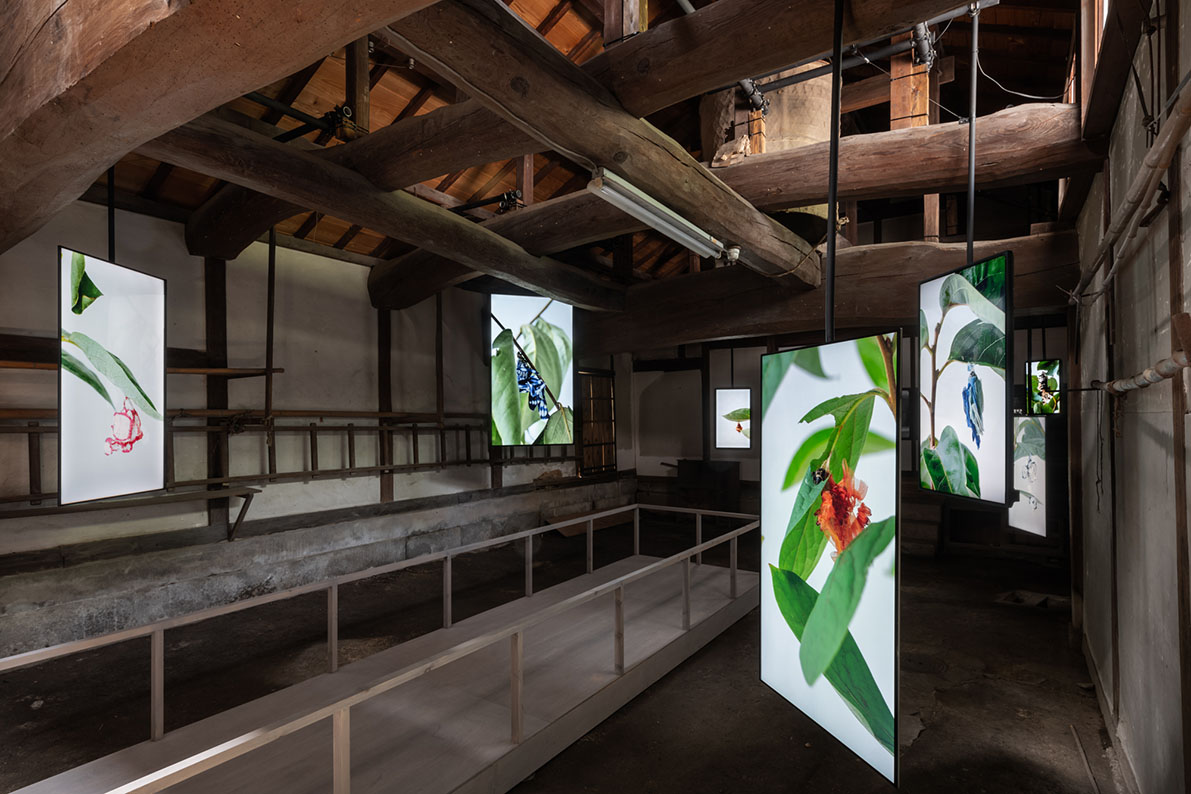ARTISTS
AKI INOMATA
- Born 1983 in Tokyo, Japan.
- Based in Tokyo, Japan.
AR06
AKI INOMATA is known for her observations of the various distinctive characteristics of life in the natural world, and her works made in “collaboration” with non-human creatures such as hermit crabs, beavers, and pearl oysters. For this exhibition, the artist worked with Shibori-Dyeing Kuno-Studio to create a kind of confusion of the tie-dyeing techniques developed in Arimatsu and the techniques used by minomushi bagworm moth larvae to create their nests. In Arimatsu-Narumi Shibori, the cloth is tied with thread, sewn and tightened, to create areas that will not take on the dye, and then dyed with a variety of patterns. INOMATA felt that this cloth in its wrapped state resembled a bagwormʼs protective cases, so she gave bagworms some Arimatsu tie-dyed cloth and asked them to make protective cases with it.
The House of Oka where INOMATA exhibits her work is a shibori tie-dye wholesaler in Arimatsu founded in the late Edo period. On display in this former workshop space is a video work entitled Passing her a piece of cloth (2022), which depicts a bagworm eating leaves while wearing a beautiful Arimatsu-Narumi Shibori protective cases. In this space with a high-ceilinged skylight, a bagworm wearing an Arimatsu-Narumi Shibori coat is displayed attached to a twig. It is said that more than 100 different patterns were created as Arimatsu-Narumi Shibori was developed, and some of the techniques used in this work are Yatara Miura Shibori, Karamatsu Shibori, Nuisuji Mokume Shibori, Boshi Shibori, Hinode Shibori, Kikai Kumo Shibori, and others.
INOMATA has also developed a new tie-dye technique based on that seen on the wings of the bagworm moth after it emerges from its chrysalis. This pattern is taken from the fungus-feeding bagworm and the wood boring moth, a species that is evolutionarily older than the common bagworm moth, and whose adult females also turn into moths and fly with their wings. This new bagworm moth pattern has been made into a fan and displayed together with chests of drawers and other objects from the Oka familyʼs Shinzashiki. The wing-shaped fan creates a breeze, as if the bagworm moth were flying.
AKI INOMATA explores relationships with living organisms beyond the human world and the things and phenomena that emerge from them. She has held solo exhibitions at the 21st Century Museum of Contemporary Art, Kanazawa (2022; Ishikawa, Japan), the Towada Art Center (2019; Aomori, Japan), and Kitakyushu Municipal Museum of Art (2019; Fukuoka, Japan), in addition to showing her work at Broken Nature at the Museum of Modern Art, New York (2021; USA) and the 22nd Triennale di Milano (2019; Italy), and is one of the artists who has been attracting increasing attention in recent years.
- Selected Works & Awards
-
- 2021
- Broken Nature, MoMA, New York, USA
- 2019
- AKI INOMATA: Significant Otherness, Towada Art Center, Aomori, Japan
- 2019
- guest room 004 AKI INOMATA Poetics of Analogy: The Process of Collaboration with Different Species, Kitakyusyu Municipal Museum of Art, Fukuoka, Japan
- 2019
- The XXII Triennale di Milano, La Triennale di Milano, Italy
- 2018
- Thailand Biennale 2018, Krabi
- 2018
- Aki Inomata, Why Not Hand Over a “Shelter” to Hermit Crabs?, Musée d’arts de Nantes, France
Exhibition
AR06

- Installation view at Aichi Triennale 2022
- Passing her a piece of cloth, 2022
- Photo: ToLoLo studio
- Open
- 10:00-17:00
*Last admission 15 min before closing time
- Closed
- Wednesdays
- Venue / Access
- House of Oka
- 5 minutes on foot from Arimatsu Station on the Meitetsu Nagoya Line.


![STILL ALIVE Aichi Triennale 2022, July 30 (Saturday) to October 10 (Monday, public holiday), 2022 [73 days]](/2022/en/img/title-logo-date-en.svg)
